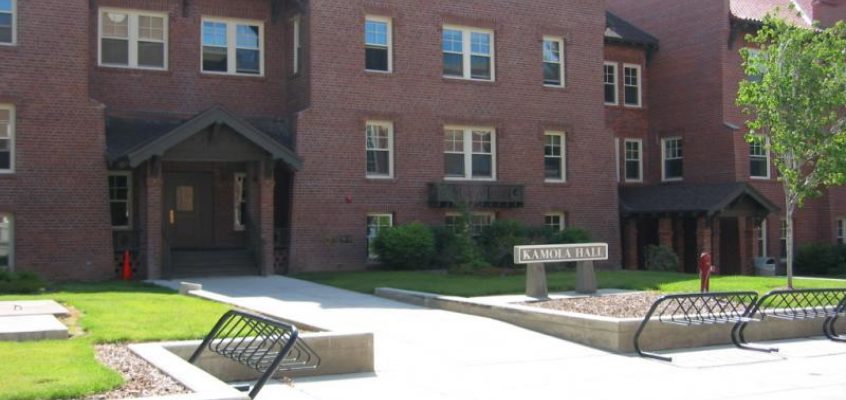CWU’s Kamola Hall was originally named simply, “the Dormitory.” Built in 1911, the red-brick structure was the first student housing structure erected on the Ellensburg campus (prior to that, students lived in housing in the community). It was expanded in 1913 and again in 1915 and 1919 to meet the demand for more living and dining space.
According to architectural historian Lauren M. Walton, the structure combines proto-Modernism styling with Spanish Colonial Revival style and hints of Gothic Revival. It was template also used in the construction of several later buildings including Sue Lombard Hall and Munson Hall. During its first three decades, Kamola Hall housed only women.
In a 2011 article in the Ellensburg Daily Record, commemorating the building’s 100 anniversary, reporter Barb Owens noted that the structure was named Kamola Hall in 1916 at the urging of Andrew Jackson Splawn, who is considered one of the founders of Ellensburg. In 1870, Splawn and a partner opened a trading post, which became known as “Robber’s Roost,” on land that is now part of downtown Ellensburg. It was the first business in Kittitas County.
Splawn, who was also a prominent local cattleman, later sold the post and the rights to 160 acres of land to John A. Shoudy, who established the settlement of Ellensburg. The town was named after Shoudy’s wife, Mary Ellen.
In May 1916, Splawn wrote a letter to the Board of Trustees of the Washington State Normal School (previous name of CWU) requesting the new women’s dormitory be named Kamola (also spelled Quo-mo-la or Quo-mallah) after the favorite daughter of Owhi, principal chief of the Kittitas band of the Yakama Nation.
Owhi, who was killed while escaping from military custody in 1858, had been a prominent figure during the Yakama Indian War of 1855 and signatory of the Treaty of Walla Walla. Kamola is said to have been born in 1843 and died in 1939.
At a meeting less than a month later, the Trustees agreed to name the dormitory Kamola Hall.
Between January 1943 and June 1944, the female students living in Kamola Hall were relocated to Munson Hall so that the former could house U.S. Air Force cadets who were training at the college. The hall then reverted to being a women’s dormitory (it became co-ed in 1974). In the 1990s, Kamola Hall was home to international students from Asia.
The structure received a $10 million renovation in 2003-2004 and remains one of CWU’s most iconic landmarks.




comments powered by Disqus